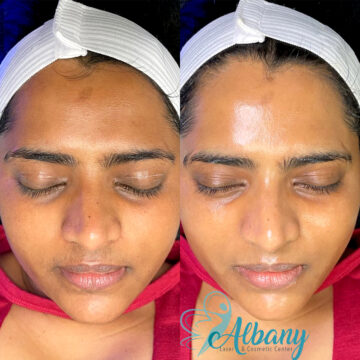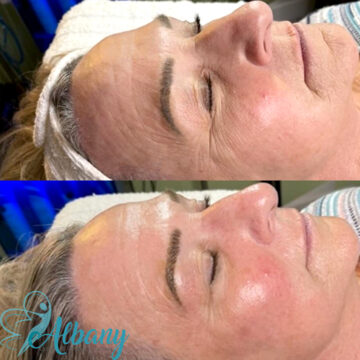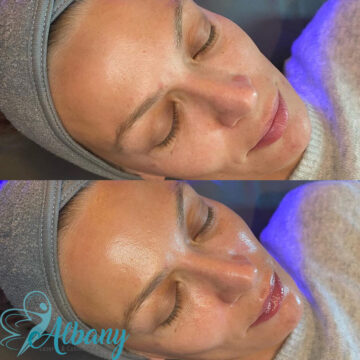Blackheads and Whiteheads in Edmonton: Causes, Treatments, Aftercare and More
Blackheads and whiteheads are the most common—and often the first—signs of acne. They fall into the category of non‑inflammatory acne and result from pores clogged with oil and dead skin cells. While these blemishes are typically less severe than pimples or cysts, they can lead to larger breakouts if not managed properly. This page explains the difference between blackheads and whiteheads, why they form, how to treat them and what to expect at Albany Cosmetic & Laser Centre.
Who Is a Good Candidate for Comedonal Acne Treatment?



Blackhead and whitehead treatments are suitable for teens and adults who:
- Experience frequent clogged pores and texture irregularities.
- Have oily or combination skin prone to non‑inflamed blemishes.
- Want to prevent the progression to inflammatory acne.
- Are willing to follow a consistent skincare regimen.
Individuals with very sensitive skin, active eczema or rosacea may require modifications to treatment. Pregnant or breastfeeding clients should consult with our providers to ensure ingredient safety.
Comedonal Acne Treatment Summary
Cost & Pricing
What To Expect
Mechanism of Action
Benefits & Results
Post-Treatment Care
Side Effects & Downtime
What Are Blackheads and Whiteheads?
Both blackheads and whiteheads begin when a hair follicle becomes clogged with sebum (oil), dead skin cells and debris. They differ in how they interact with the air:
- Blackheads (open comedones): The pore remains open, allowing air to oxidise the trapped oil and keratin. This oxidation turns the material dark, giving blackheads their distinctive colour. They often appear on the nose, forehead, chin and sometimes the chest or back.
- Whiteheads (closed comedones): The follicle opening closes over, trapping a mixture of oil and dead skin under a thin layer of skin. Because the material isn’t exposed to air, it retains a white or flesh‑coloured appearance. Whiteheads may form on the face, particularly the cheeks and around the mouth, as well as on the shoulders and chest.
These comedones are considered non‑inflammatory because they lack significant redness, swelling or pain. However, they can progress to papules, pustules or cysts if bacteria proliferate and the pore wall ruptures.
Why Do Blackheads and Whiteheads Form?
Several factors contribute to comedone formation:
- Excess oil production: Hormonal fluctuations—particularly in adolescence, pregnancy or during menstrual cycles—increase sebum output, clogging pores.
- Irregular shedding of skin cells: When dead skin cells don’t slough off properly, they mix with oil and block pores.
- Bacteria and biofilm: The skin’s natural bacteria can form a biofilm that traps debris inside pores.
- Heavy skincare or hair products: Comedogenic ingredients in makeup, sunscreen or hair oils can block follicles.
- Diet and lifestyle: High glycaemic diets, dairy products and stress may contribute to oily skin and clogged pores in some individuals.
- Environmental factors: Heat, humidity and pollution increase oiliness and sweat, which mix with dead cells to form plugs.
Treatments for Blackheads and Whiteheads
Because comedonal acne is non‑inflammatory, gentle yet consistent care clears blockages and prevents future buildup. Options include:
- Topical exfoliants: Products containing salicylic acid (beta‑hydroxy acid) penetrate oil and dissolve debris inside pores. Alpha‑hydroxy acids (glycolic, lactic) exfoliate surface cells and encourage cell turnover.
- Retinoids: Over‑the‑counter adapalene or prescription tretinoin normalise cell turnover, preventing the formation of new comedones. Retinoids also help existing blackheads and whiteheads rise to the surface and clear away.
- Benzoyl peroxide: Reduces bacteria and can help with whiteheads that are at risk of becoming inflamed. Lower concentrations minimise irritation.
- Professional extractions: A trained clinician gently removes blackheads and whiteheads using sterile tools. Proper technique reduces the risk of skin trauma and scarring compared with DIY squeezing.
- Chemical peels: Light peels with salicylic or glycolic acid exfoliate the top layers of skin and clear clogged pores. Series of peels can improve texture and tone.
- Microdermabrasion: A machine gently abrades the surface skin to remove dead cells and stimulate cell turnover. It’s most effective on superficial comedones.
- Lifestyle adjustments: Using non‑comedogenic skincare and makeup, cleansing after exercise and avoiding heavy lotions or oils on the face can prevent pore blockage.
Most people benefit from combining at‑home skincare with periodic professional treatments to maintain clear pores and healthy skin.
Benefits of Treating Blackheads and Whiteheads
Clearer, Smoother Skin
Regularly clearing clogged pores improves skin texture and reduces the appearance of bumps, giving your complexion a more refined look.
Prevents Progression to Inflammatory Acne
Keeping pores free of debris reduces the chance that bacteria will proliferate and cause painful pimples, nodules or cysts.
Low Downtime and Minimal Discomfort
Comedone treatments are gentle and require little to no recovery time, making them easy to incorporate into your routine.
Customizable and Maintenance Friendly
You can adjust your skincare regimen and professional treatments based on season, hormonal fluctuations and lifestyle changes to maintain clear skin.
Why Choose Albany Cosmetic & Laser Centre for Comedonal Acne Treatment?
Our clinic offers a comprehensive approach to treating blackheads and whiteheads:
- Expert assessment: We identify the underlying causes of your clogged pores and tailor treatments accordingly.
- Advanced treatments: We provide professional extractions, chemical peels, microdermabrasion and personalised skincare plans.
- Education and support: We teach you how to maintain clear pores at home and offer follow‑up appointments for monitoring.
- Transparent pricing: You’ll know the costs of treatments and packages up front, with no hidden fees.
Transparent Pricing
A single extraction or peel session starts at $75. Packages of three to six treatments are available at discounted rates (for example, $200–$600), which may include home‑care products. We will provide a custom quote during your consultation.
Combining Comedonal Acne Treatment with Other Services
Once blackheads and whiteheads are under control, you can consider additional treatments to refine your complexion:
- Microneedling: Stimulates collagen production to improve fine lines and mild textural issues.
- Hydrafacial: Provides deeper cleansing, extraction and hydration in one session.
- Laser genesis: Boosts collagen and improves overall tone and texture.
- Customised skin‑care plans: Medical‑grade serums and sun protection help maintain healthy skin.
We’ll discuss timing and options during your consultation.
Frequently Asked Questions
- What’s the difference between a blackhead and a whitehead?
- Both are clogged pores, but blackheads stay open to the air, which oxidises the contents and turns them dark. Whiteheads remain covered by skin, so the trapped material retains a white or flesh tone.
- Can I squeeze blackheads or whiteheads at home?
- It’s best to avoid squeezing or picking at comedones. Doing so can push debris deeper into the skin, cause inflammation and lead to scarring. Professional extractions are safer.
- How long does it take for treatments to work?
- You may start to see improvements within 2–4 weeks of using salicylic acid, retinoids or other exfoliants. Consistency is key, and professional treatments can accelerate results.
- Are there specific ingredients I should look for?
- Salicylic acid, glycolic acid, lactic acid, retinoids and benzoyl peroxide are common ingredients that target comedonal acne. Look for products labelled “non‑comedogenic.”
- Do diet and lifestyle affect blackheads and whiteheads?
- For some people, high‑sugar or high‑dairy diets can increase oil production and clog pores. Managing stress, staying hydrated and eating a balanced diet may help keep your skin clear.
- Is sunscreen important for acne‑prone skin?
- Yes. Many acne treatments increase sun sensitivity. Choose a lightweight, oil‑free sunscreen to protect your skin without clogging pores.
- Can blackheads and whiteheads turn into pimples?
- Yes. If bacteria multiply within a clogged pore and the wall of the follicle ruptures, a blackhead or whitehead can become an inflamed pimple or cyst.
- Do pore strips work for blackheads?
- Pore strips may remove the tops of blackheads temporarily but don’t address deeper buildup or prevent new plugs. Regular exfoliation and professional care are more effective long‑term solutions.
- How often should I get professional extractions?
- Frequency depends on your skin type and severity of clogged pores. Many clients benefit from professional extractions every 4–6 weeks, combined with a consistent at‑home routine.
- Can I use makeup if I have blackheads and whiteheads?
- Yes, but choose non‑comedogenic, oil‑free products and remove them thoroughly every night. Avoid heavy, occlusive creams and powders that may block pores.
- What if my skin becomes dry or irritated?
- Mild dryness is common when starting exfoliating products. Use a gentle moisturiser, reduce frequency of application and consult your provider if irritation persists.
- When should I see a dermatologist?
- If over‑the‑counter treatments aren’t effective after several weeks, or if your comedones are accompanied by painful pimples or scarring, it’s time to seek professional guidance.
Treatment Preparation and Aftercare Timeline
Preparing for Your Appointment
Avoid using any harsh exfoliants, waxing or aggressive skincare for several days before your visit. Come to your appointment with clean, makeup‑free skin. If you’re using prescription acne medications, let us know so we can coordinate your care.
What to Expect During the Procedure
Depending on your needs, your visit may include:
- Skin analysis: We examine your skin to determine pore size, oil production and sensitivity.
- Professional extraction: Using sterile tools, we gently remove blackheads and whiteheads without damaging the surrounding skin.
- Chemical peel or microdermabrasion: A light peel or mechanical exfoliation may follow to clear any remaining debris and smooth the skin.
- Product recommendations: We’ll suggest at‑home products to keep your pores clear and minimise future breakouts.
Aftercare and Recovery
To maintain results after your appointment:
- Keep skin clean: Use a gentle, pH‑balanced cleanser twice daily. Avoid scrubbing or harsh scrubs.
- Moisturise and protect: Even oily skin needs hydration. Choose a lightweight, non‑comedogenic moisturiser. Apply sunscreen (SPF 30+) daily.
- Exfoliate carefully: Incorporate salicylic or glycolic acid products two or three times per week, as directed. Don’t over‑exfoliate, which can irritate skin and cause more breakouts.
- Hands off: Resist touching or squeezing any remaining comedones. Picking can drive debris deeper and cause inflammation or scarring.
- Follow our plan: Use recommended retinoids or other topicals consistently and return for periodic maintenance treatments as advised.
Read our privacy policy here